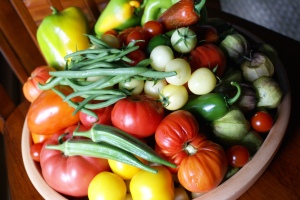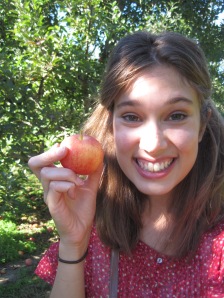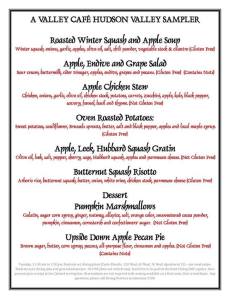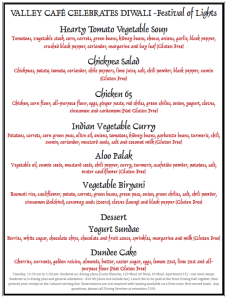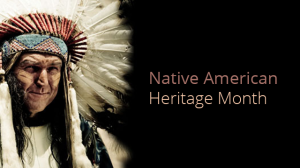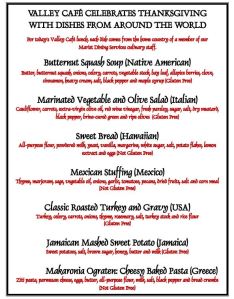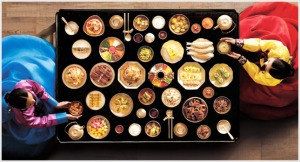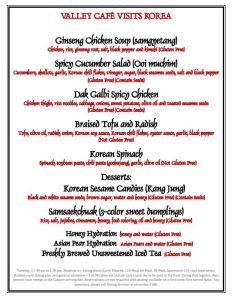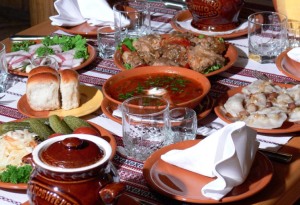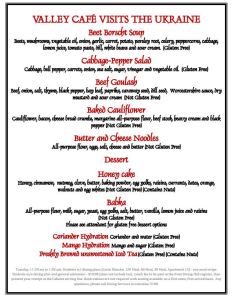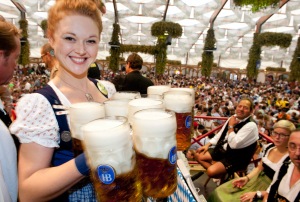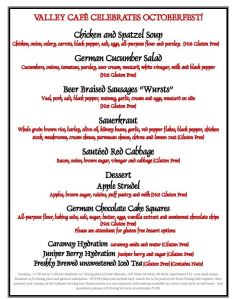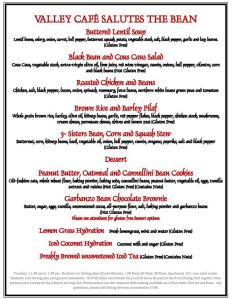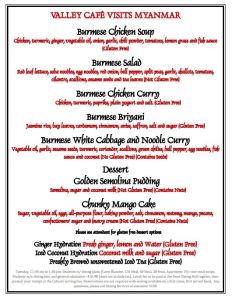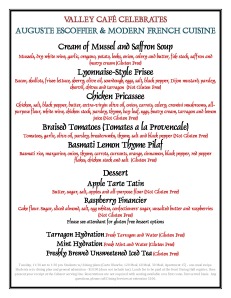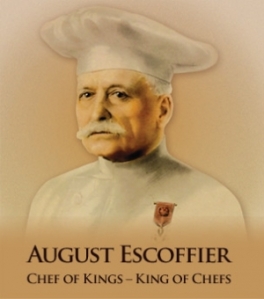Theme of the Week
Wrapping Up the Fall Semester with the Fall Harvest
Fall is, without a doubt, my favorite time of the year. I love the changing colors of the trees, the crisp evening air and the kick off of soccer season. But most of all, fall of is full of the best food and flavors like apple pie, pumpkin muffins and cranberry sauce.
The taste of fruits and vegetables are the most fresh when they are in season and the fall harvest does not disappoint with options. Favorites like sweet potatoes, pomegranates, pears, arugula, cauliflower, grapes, celery, peppers and kale are just some of the produce harvested in the late summer and fall season. Classics like apples and squash are a symbol for the season itself.
It’s fun to join in on the fall harvest spirit. Things like apple picking, hay rides and pumpkin patches are a simple way to celebrate fall and support the seasonal harvest. Even I get really into it… (c’mon, how cute is that tiny apple?!)
On Tuesday the Valley Café celebrates the fall harvest that has provided our meals all semester. The event will be an acknowledgement of locally grown food and also fresh and flavorful seasonal food. It only seems appropriate to end the Valley Café semester with a menu that brings the whole experience together. On Tuesday we’ll taste the seasonal favorites we have enjoyed all semester while continuing to thank the many local farmers who have grown for us this fall.
Pumpkin, squash, apples and potatoes will be overflowing at the Valley Café on Tuesday. Come join for the last event of the semester in the Cabaret from 11:30 to 1:30!
This entry was posted in Menu, Theme of the Week and tagged fall harvest, local sourcing, Marist, Marist College, Marist Dining, menu, seasonal food, Valley Cafe.
The Festival of Lights
The menu at this week’s Valley Café features Indian cuisine in celebration of the Hindu festival of Diwali, also known as the festival of lights.
The origins of Diwali can be traced back to India but there are many different legends about its origin. Today it is a national holiday in India, Nepal, Sri Lanka, Myanmar, Singapore, Fiji and most of Southeast Asia. Each of the four days of Diwali (Naraka Chaturdasi, Amavasya, Kartika Shudda Padyami and Yama Dvitiya) tells its own legend of Hindu gods and demons and the triumph of good over evil. The celebration includes the sharing of food and sweets, new clothes, colored sand designs and lots and lots of lights. Fireworks and firecrackers are lit to drive away evil spirits and to express joy to the gods. Small clay lights filled with oil are kept all around the home and provide a peaceful glow day and night. The term “Diwali” actually translates into “row of lamps”.
Diwali is about awareness of the inner light that exists within us all. It is pure and infinite and from our inner light stems reason, hope and compassion. Each one of us celebrates the birth of our physical being. In addition, Diwali celebrates the glow of this inner light.
Join in the festival of lights at the Valley Café on Tuesday, November 26th from 11:30-1:30 with a Diwali inspired menu.
See you then!
(Picture courtesy of CNN)
This entry was posted in Menu, Theme of the Week and tagged Diwali, Festival of Lights, Indian culture, Indian food, Marist, menu, Southeast Asia, Valley Cafe.
Native American Roots
Thousands of years before Christopher Columbus and his ships arrived in the Bahamas, the nomadic ancestors of modern Native Americans were living in North and South America. Scholars estimate that before Europeans discovered the Americas there were already 50 million people living on the land, with about 10 million of those settled in the area that is now the United States. The Native Americans in this region were essentially the first contributors to the establishment of the United States. Even though European settlers are often credited with establishing the structure that has built our current society, it is the Native Americans who were the original developers and, in many cases, teachers for the European explorers.
In 1990, President George H. W. Bush declared the month of November as National Native American Heritage Month to commemorate the people who first settled on our land and spread awareness of Native American culture and way of life.
The Valley Café is also eager to spread the Native American culture this November through our menu on Tuesday, November 19th. Like our local farmers, Native American culture has also traditionally felt a very close tie to the land. As a source of food and life, the earth and the soil are precious.
Traditional Native America cuisine contains the staple crops: corn, beans and squash (the “Three Sisters”, as we learned about earlier during the semester in our bean themed menu). Native Americans grew these three crops because of their interdependence on one another–beans grow up the stalk of the corn and squash grows at the base of the plants providing protection and support for the roots. You’ll notice these three ingredients (particularly corn) as dominant parts of Tuesday’s menu.
Embrace the Native American culture and celebrate Native American Heritage Month from 11:30 to 1:30 at the Valley Café!
(Picture courtesy of PBS)
This entry was posted in Menu, Theme of the Week and tagged Marist, menu, Native American cuisine, Native American Heritage Month, Native Americans, November, Valley Cafe.
Thanksgiving Comes Early
It’s officially November and the season to give thanks.
The Valley Café would like to thank all the visitors who attend each week and celebrate good food, people and the benefits to local sourcing. Although each week we are conscious of the farmers who grow our meal, there is also a lot of hard work that goes into cooking and preparing the food.
This week Chef Anthony has chosen to create a Thanksgiving menu to celebrate the holiday and also give thanks for the members of his culinary staff. This Thanksgiving meal contains the classics–turkey, gravy, sweet potatoes, stuffing and vegetables…but with a twist. Each dish represents a cuisine from the mother country of most of the Sodexo staff that prepares our meals. This international Thanksgiving reflects the diversity of the culinary staff with Native American, Italian, Hawaiian, Mexican, Jamaican, Greek, Filipino and Albanian cuisine. Even a Jewish meal is featured, since the first day of Hanukkah coincidentally falls on Thanksgiving.
The culinary staff at Marist are as close as family, explains Chef Anthony: “In the food industry due to long hours, close quarters and just about every emotion a human can go through, you in a sense become ‘family’. In most kitchens the staff prepare a meal, fix themselves a plate and sit down and have the meal together like a family.” It’s this close bond that inspired Chef to show thanks for the people he works with: “With all the diversity we have in staff, why not represent a dish in each cuisine of their motherland?”
Celebrate Thanksgiving early at Tuesday’s Valley Café and show some thanks for our hardworking culinary staff here at Marist!
This entry was posted in Menu, Theme of the Week and tagged international cuisin, Marist, menu, Thanksgiving, Valley Cafe.
Korean Cuisine
A typical meal in Korea is one in which everyone shares many different side dishes. This sharing reflects Korea’s collectivist culture where individuals identify themselves with the group and tend to the groups needs over his or her own. On Tuesday, November 5th the Valley Café provides the opportunity to join the Korean dining experience made largely up of grains, vegetables and meats.
Grains can be found in the early myths of Korean kingdoms. Rice, however, is not indigenous crop of Korea; it was brought to the area during the Three Kingdoms Period of the first century. In some areas, rice was considered such an important commodity that it was used to pay taxes. Today, a traditional bowl of white rice is essential to a meal. Vegetables like Korean radish, Napa cabbage and cucumber are often served alongside rice in salads or stews and stir-fry dishes. It’s also common for medicinal herbs such as ginseng to be used as ingredients.
In general, meals in Korea contain less meat that Western or Chinese cuisine. Chicken and pork are an important source of protein in a Korean diet and Koreans like to use all parts of the animals in a meal. Beef has always been the most prized of meats because cattle is viewed as essential to the home for labor and as a member of the family. Beef has not been eaten very often until recently. Fish and seafood are popular especially in the coastal areas since Korea is located on a peninsula in the Indian Ocean.
Korean food has become more popular around the world because of its health benefits and this week many of these elements of traditional Korean cuisine can be found in the Valley Café menu! Join us for lunch on Tuesday from 11:30-1:30 to taste the rich, unique culture of Korea.
(Picture courtesy of visitkorea.org)
This entry was posted in Menu, Theme of the Week and tagged Korea, Korean cuisine, Marist, menu, Valley Cafe.
Ukrainian Cuisine
On Tuesday, October 29th the Valley Café will feature cuisine from Ukraine!
Ukraine is a country in Eastern Europe located just north of the Black Sea and bordered by countries like Russia, Poland and Hungary. The country has had its borders changed many times, especially during the Soviet era when it was one of the republics of the Soviet Union. During this time, the country experienced chronic food shortages which had a huge influence on the development of the country’s cuisine.
Ukrainian cuisine originates from peasant dishes based on inexpensive and easily accessible ingredients like bread, potatoes, cabbage and beets. Soups made from these ingredients were simple and easy to cook and the main part of a typical Ukrainian diet. These dishes were profound until the the 17th and 18th century when the tsars started to bring French and Italian chefs to the country to cook for their elaborate banquets. The more luxurious dishes soon left their influence on Ukrainian cuisine and added new spices and herbs such as black pepper, red pepper, salt, bay leaf, parsley, dill, garlic and onion. Meat is also now eaten more often (particularly due to the agricultural development of the country) with favorites being pork, beef and sausage prepared either as stewed, boiled, fried or smoked.
Today a typical Ukrainian meal is a blend of simple, rustic cooking and unique, modern dishes. Tuesday’s Valley Café menu incorporates many of these essential Ukrainian ingredients in the Beet Borschch Soup, Beef Goulash and Cabbage-Pepper Salad (see the full menu here). Join us Tuesday from 11:30-1:30 and experience tastes straight from Eastern Europe!
(Picture courtesy of travel2ukraine.info)
This entry was posted in Menu, Theme of the Week and tagged food, Marist, menu, recipe, Ukraine, Ukrainian cuisine.
Celebrating Oktoberfest
The 2013 Oktoberfest celebration recently ended back on October 6th. This week the Valley Café will be keeping the spirit alive with an Oktoberfest themed meal!
The Oktoberfest festival is the world’s largest fair held for 16 days from late September to early October in Munich, Germany. More than 6 million people from all around the world attend the event each year to eat traditional German food like Würstl (sausages), Brezen (pretzel) and Sauerkraut and to drink the famous steins of beer in the crowded beer halls. In order to be served at Oktoberfest, the beer much have a minimum of 13.5% Stammwürze (approximately 6% alcohol by volume) and be brewed in Munich.
The fair has been held since 1810 when the citizens of Munich were invited to celebrate the marriage of Prince Ludwig and Princess Therese of Saxe-Hildburghausen on October 12. The event has developed continuously since then, even after having been cancelled 24 times due to epidemics and war. Oktoberfest has become a symbol of the Bavarian culture and an important event for the local Germans who refer to the event as “die Wies’n”, after the name of the fairgrounds.
Oktoberfest showcases German cuisine and culture and the Valley Café menu for October 21st will as well. But I also believe the event is a celebration of many cultures coming together, enjoying each other’s company and sharing a love for good food and drink.
Oktoberfest 2014 is scheduled to take place from September 20th-October 5th…but for now, enjoy a German meal on us.
Anyone ever been to Oktoberfest? Please feel free to share your experience in a comment.
This entry was posted in Menu, Theme of the Week and tagged German food, Germany, Marist, Munich, Oktoberfest, Valley Cafe.
Salute the Bean
Thousands of years ago, hunter-gatherers and nomadic people changed their lifestyle and began to settle in one place. This would dramatically alter the course of human history. To support themselves they tilled the earth and grew crops, creating the first systems of agriculture. Growing crops became essential to survival and a personal favorite of the time were beans.
Evidence has shown how prevalent the bean crop has been throughout history. The native people of Mexico and Peru were growing beans as far back as 7000 B.C. Chickpeas, fava beans and lentils have been found in 4000 year old Egyptian tombs. Parts of Asia were growing and using soybeans also around the same time period in 1500 B.C. High in fiber, protein and carbohydrates, the beans provided these people with everlasting energy.
Beans have been an integral part of the development of humanity and culture. This week’s Valley Café celebrates one of the world’s first cultivated crops by designing the menu around the bean. Other originally cultivated crops such as grains (including wheat, barley, millet, rice and corn) will also be included in the Valley Café menu. Together the amino acids of beans and grains complement each other to form a complete protein, the foundation for human growth and development and the ultimate meal!
It’s appropriate for the Valley Café to salute the bean in this week’s menu because doing so also celebrates the world’s first farmers. Traditional, local, hardworking farmers are at the core of the Valley Café.
Join us for a bean filled meal on Tuesday, October 15th!
This entry was posted in Menu, Theme of the Week and tagged beans, first cultivated crop, food, grains, Marist, menu, recipe, Valley Cafe.
Myanmar Cuisine: Combining the Best of Asia
This week the Valley Café blends the best of Asian cuisine with a menu from Myanmar.
The Republic of the Union of Myanmar (also known as Burma) is the second largest country in Southeast Asia known for its well-preserved culture. Ancient Myanmar traditions are still very relevant today, despite the modernization of the region. Some key elements of the Myanmar culture are the country’s native music, its strong Buddhist beliefs and, of course, food.
Traditional Burmese cuisine is considered a unique fusion of Chinese, Indian and Thai. The use of noodles and soy sauce are adopted from China and the making of curry is an Indian tradition (although Myanmar curries are typically not as spicy). Thai influence comes from the use of lemongrass, fish sauce and coconut. When considering the blend of all three cultures, the food of Myanmar can be considered more rich than Chinese but not as spicy as Indian or Thai.
Burmese cuisine can also be classified by the variety of flavorful spices used in each cooking. Fish is commonly used in dishes, especially in the coastal region of the country. Rice is also an essential part of each meal, as it is for many Asian cultures. White rice is the staple food of Myanmar but the most popular is the highly priced Basmati Rice.
Join us at the Valley Café this Tuesday to taste the many flavors of the Myanmar culture!
(Picture courtesy of telegraph.co.uk)
This entry was posted in Menu, Theme of the Week and tagged Asian cuisine, Burma, Burmese cuisine, culture, food, menu, Myanmar, recipe.
French Cuisine with Auguste Escoffier
This upcoming Tuesday, October 1st the Valley Café will be going to France.
Chef Anthony has designed the menu with inspiration from the work of French chef and restaurateur Georges Auguste Escoffier, who represents this week’s theme.
Escoffier is a legendary figure in the culinary field and a key leader in the development of modern French cuisine. He showed early promise as an artist and began an apprenticeship in his uncle’s restaurant in Nice by the age of thirteen. Later in life he ran the kitchen of Hotel National in Lucerne where he met César Ritz. Together they formed a hotel partnership, with Escoffier in charge of the kitchen. He eventually set up the kitchens and recruited the chefs for the high status clientele of the Ritz-Carlton Hotel chain in both Paris and London.
Escoffier introduced an organized discipline to the kitchen that helped elevate the status of the culinary profession. He also worked to simplify the elaborate cooking styles of the time, particularly the recipes for five mother sauces. Escoffier was France’s most distinguished chef of the early 20th century and the French press referred to him as roi des cuisiniers et cuisinier des rois (“king of chefs and chef of kings”).
Come enjoy the tastes of France at the Valley Café on October 1st!
(Photo courtesy of escoffier.edu)
This entry was posted in Menu, Theme of the Week and tagged Auguste Escoffier, culinary history, food, France, French cuisine, Marist, menu, recipe, Valley Cafe.
- ← Previous
- 1
- 2
